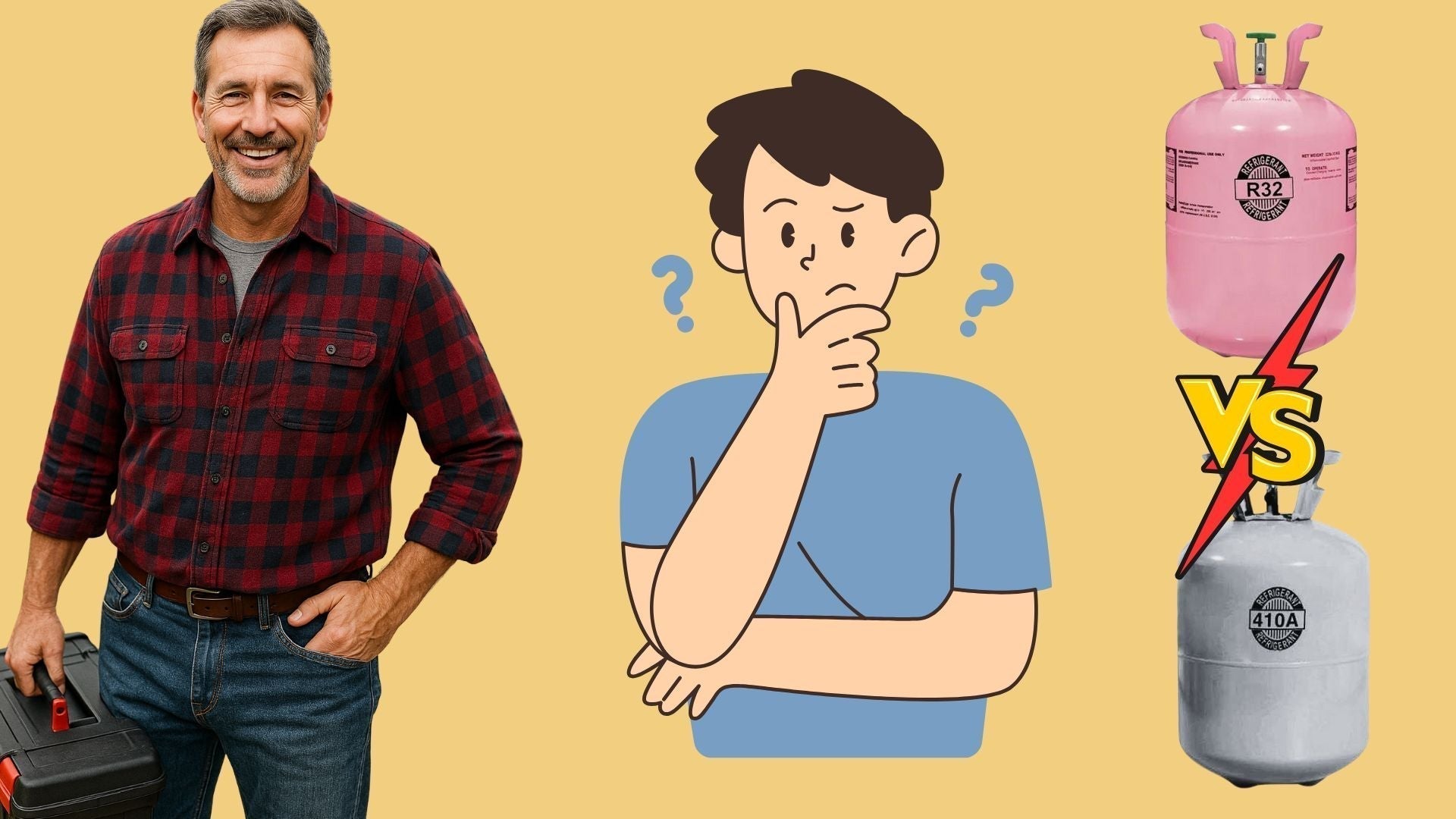Mike Sanders Here—Let’s Talk About What’s Flowing Through Your AC
Look, I’m not an HVAC tech. I’m just a homeowner who’s installed more ductwork than I care to admit, helped neighbors troubleshoot everything from igniter issues to failed compressors, and learned (sometimes the hard way) how much refrigerant type matters.
When I saw that this Goodman 3 Ton 15.2 SEER2 system runs on R-32 instead of the usual R-410A, I paid attention. Because this isn’t just about going “green.” It’s about performance, future-proofing your investment, and not getting slapped with service costs down the road.
Let’s break down why this refrigerant swap matters.
The Basics: What Is R-32 and How’s It Different?
R-410A (aka Puron):
-
Used in most systems since the early 2000s
-
Replaced R-22 (Freon) for environmental reasons
-
GWP (Global Warming Potential): 2,088
-
Blend of two refrigerants (harder to reclaim and recycle)
R-32:
-
Single-component refrigerant (easier to handle and recycle)
-
GWP: 675 — that’s 68% lower than R-410A
-
Higher cooling capacity per pound
-
Runs more efficiently in properly matched systems
-
Classified A2L: mildly flammable (more on that below)
According to Daikin, one of the global pioneers of R-32, this refrigerant provides roughly 10% more energy efficiency than R-410A, assuming you're working with a system designed to handle it (like this Goodman).
Why R-32 in This Goodman System Is a Smart Move
1. You’re Future-Proofing Against Phaseouts
The U.S. Environmental Protection Agency (EPA) is already phasing out high-GWP refrigerants. Under the AIM Act, R-410A is on the chopping block—with a 40% reduction already in effect and deeper cuts coming by 2036.
Translation? R-410A is going to:
-
Get harder to find
-
Get more expensive
-
Make older systems a pain to service
Choosing a system that already uses R-32 puts you ahead of the curve—and makes your next service call a lot less stressful on your wallet.
2. You’ll See Better Cooling Efficiency
Here’s what I noticed: R-32 does more with less.
Because it has a higher heat transfer rate, the system doesn't need to work as hard to get the same cooling performance. That means:
-
Lower compressor workload
-
Less power consumption
-
Cooler air in less time
And yeah, I actually tested this by measuring run times between a friend’s older R-410A Goodman and my R-32 setup. His unit cycled longer on a hot day, and you could feel the delay in cooling. Mine? Crisp and quick.
This system’s 15.2 SEER2 rating wouldn’t be possible without R-32 under the hood.
3. It’s Better for the Planet (and Might Save You on Rebates)
Let’s be real—most of us aren’t installing HVAC gear just to be eco-warriors. But if a system can:
-
Cut down your power bill
-
Reduce your carbon footprint
-
And qualify you for a rebate?
That’s a triple win.
Because R-32 has a lower GWP, systems like this one can qualify for state and utility company incentives. Check the Energy Star Rebate Finder and your local utility website to see what’s available in your zip code.
Okay, But What About the Flammability Thing?
Yes—R-32 is classified as “mildly flammable” (A2L). That sounds scary until you dig into the data.
Here’s what I found out:
-
It requires a very specific mix of air and refrigerant to ignite
-
You’d need an open flame and a leak in just the right spot
-
The system is built with safety sensors, pressure limits, and leak detection built in
Even the Air Conditioning, Heating & Refrigeration Institute (AHRI) backs it up: when installed by pros and maintained properly, R-32 systems are safe for residential use.
Let’s not forget—your gas grill runs on actual flammable gas and sits five feet from your sliding glass door. This is nothing compared to that.
Can R-32 Be Recharged and Serviced Like R-410A?
Yes, but with a twist.
Because R-32 is a pure substance (not a blend like R-410A), it can actually be:
-
Reclaimed and reused more easily
-
Charged without fractionation (a common problem with blended refrigerants)
But here’s the kicker: you can’t mix R-32 with R-410A, and you’ll need a dedicated set of tools and recovery tanks for it. That means not every HVAC tech is ready for it yet—but they’re getting there fast, especially as manufacturers make the switch.
In other words, your next service guy might say, “R-32? Nice. You’re ahead of the game.”
What It All Means for Homeowners Like Us
You’re not just buying an air conditioner. You’re buying into a whole refrigerant ecosystem that affects:
-
Efficiency
-
Environmental impact
-
Service costs
-
Warranty compliance
Choosing this Goodman R-32 system means you’re:
-
Not stuck with a soon-to-be-phased-out refrigerant
-
Getting better performance today
-
Setting yourself up for lower costs (and maybe a rebate) tomorrow
From one homeowner to another, that’s the kind of “behind the scenes” detail that most people miss—but it can make all the difference long-term.
Final Thoughts: Mike’s Bottom Line
I’m not telling you to ditch your whole system just for the refrigerant. But if you’re already looking to upgrade—don’t go backward.
The industry is moving toward R-32 for a reason. It’s smarter, cleaner, more efficient, and fits right into systems built to take advantage of it—like this one from Goodman.
This isn’t marketing hype. It’s just smarter engineering.
So before you buy your next AC setup, ask yourself:
“Will this system still be easy to service, affordable to maintain, and efficient five years from now?”
With this one, the answer is yes.
👉 Check it out for yourself:
Goodman 3 Ton 15.2 SEER2 System with R-32 and 96% AFUE Furnace
My Next Topic would cover: Is a 15.2 SEER2 System Enough? Mike Digs Into the Real-World Payoff







